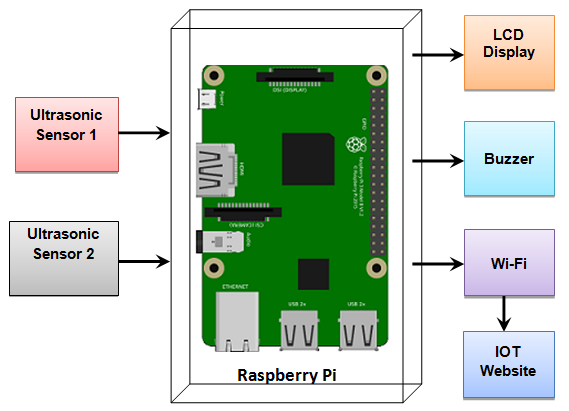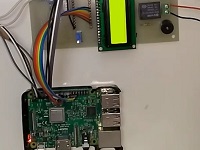The IOT garbage monitoring using the Raspberry Pi project consists of a power supply circuit, ultrasonic level sensors, a Raspberry Pi that acts as a digital controller, an LCD display, and a remote server. The IOT and Raspberry Pi-based garbage monitoring project monitors the fill level of the bins by means of ultrasonic sensors. The concerned person is notified when the bin reaches the full level, by means of an alarm buzzer.
₹ 11,200
Project Code: 6132

Problem description
With the phenomenal increase in the world population and rapid growth of urban centers, many environmental, ecological, and social problems are on the rise. Garbage disposal is one of the major problems that are being faced regularly in homes, offices, industries, hospitals, and schools. Improper management of garbage disposal can result in hygiene and health-related issues. Garbage monitoring and disposal in large offices, institutions, and industries are particularly a problem. Forgetting to dispose-off a bin full of garbage can cause many problems. In first-world societies, negligence in timely garbage disposal can result in hefty fines and penalties. We have come up with an IOT Garbage Monitoring Using Raspberry Pi project to solve these issues.
Introduction to the IOT Garbage Monitoring Using Raspberry Pi project:
Smart technologies can be employed for avoiding human errors and negligence in the garbage disposal process. For this purpose, a smart garbage monitoring project is proposed. This project is based on a Raspberry Pi controller and IOT communication technology.
The power supply is responsible for supplying a stable 5V DC voltage to all the DC-powered devices in the electronic system. It consists of a full-wave diode bridge rectifier, a voltage regulator IC and passive electronic components. The power supply converts high-level AC voltage to low-level DC voltage.
Project operation
The IOT garbage monitoring using the Raspberry Pi project uses two ultrasonic sensors to monitor the garbage level of two bins. The ultrasonic sensors consist of a transmitter and a receiver. They work on the principle of Doppler’s effect. The sensor generates an ultrasonic wave that reflects back after colliding with an obstacle or an object. The time-lapse between the transmission and reception of the ultrasonic wave is measured by the ultrasonic sensor and the distance calculation is made based on this time-lapse value. The distance measured by the sensor in our case is the distance between the sensor and the surface level of the garbage.
The garbage fill level of the bins as measured by the ultrasonic sensors is continuously fed to the Raspberry Pi single-board computer. The Raspberry Pi controller processes this data and transmits it to the output devices as well as the remote servers.
Data sent over the cloud using IOT:
The real-time garbage fill level of each bin is displayed on an LCD display. In addition to that, the data is also transmitted to a remote server by means of IOT protocols. An IOT platform like ThingSpeak is used to receive, store, and visualize this data. A graphical user interface is built using the ThingSpeak IOT platform, which visualizes the sensor data with respect to time, in the form of a graph.
Block diagram of the IOT Garbage Monitoring Using Raspberry Pi:

Block diagram description of the IOT Garbage Monitoring Using Raspberry Pi Project
The project block diagram of the IOT garbage monitoring using Raspberry Pi project consists of 7 elements or subsystems.
- The first subsystem is the power supply unit which is responsible for converting the AC voltage to low-level DC voltage and providing a stable DC-level voltage to all the DC-powered devices in the electronic system. The power supply circuit consists of a bridge rectifier, voltage regulator, and passive components.
Input blocks:
- The next two blocks are the ultrasonic sensors. These sensors employ the Doppler effect principle for the measurement of garbage levels in the bins. These sensors continuously monitor the garbage level in the bins and transmit the data to the Raspberry Pi controller.
Raspberry Pi / The main processing unit of the project:
- The 4th system block is the Raspberry Pi controller. This is a single-board computer based on a microprocessor, which can be interfaced with input, output, and slave devices. The Raspberry Pi board has built-in WiFi, USB ports, Bluetooth, HDMI interface, and GPIOs. The most popular language for programming the Raspberry Pi is Python which is a high-level general-purpose programming language. Like all other computers, Raspberry Pi also requires an operating system for system-level operations. The officially supported operating system for the Raspberry Pi is called Raspbian, which is a variant of Linux OS. Linux OS is the most popular and widely used open-source operating system in the world. Raspberry Pi is the main controller in our project which gathers data from the input devices and transmits it to the output devices.
Output blocks:
- The 5th and 6th blocks in our project block diagram are the LCD screen and the buzzer. When the garbage level reaches a specified level, the buzzer is turned on so that the concerned person can be notified. The real-time values of the garbage sensors are displayed on the LCD screen so that the concerned person can monitor the fill level of the bins at any given time.
- The 7th block in the project is the remote server-based GUI. The Raspberry Pi controller sends off the sensor data to a remote server by means of IOT protocols. The ThingSpeak IOT platform gathers this data and stores it. This data is then visualized by means of a GUI built in the ThingSpeak IOT platform. The sensor values are plotted as graphs so that the bin levels can be monitored from a remote central control room.
Applications, advantages, and enhancements of the project
- Raspberry pi based IOT garbage monitoring projects can be used for the monitoring and management of garbage in big organizations and industries where dozens of bins are present.
- The IOT garbage monitoring using Raspberry Pi can also be used in homes for the purpose of automatic garbage disposal reminders.
- This project uses reasonably priced components and devices. This project provides a cost-effective garbage monitoring solution.
- The IOT-enabled operation of this system makes it very powerful and it can be used to monitor any number of bins from a remote centralized or distributed location.
- The size of the IOT garbage monitoring using the Raspberry Pi project can be made more compact by using the NodeMCU ESP8266 board instead of the Raspberry Pi board.
- Additional ultrasonic sensors can be integrated into the system to monitor more bins and to create a more complex system.

